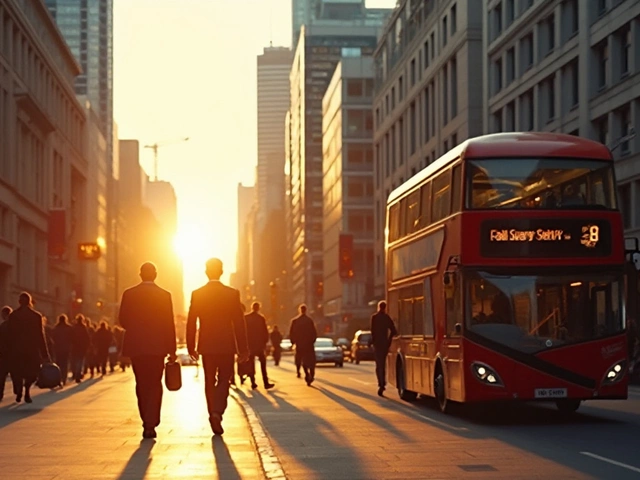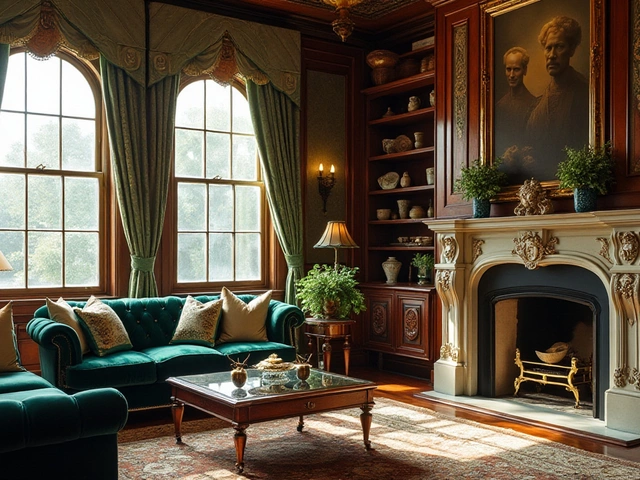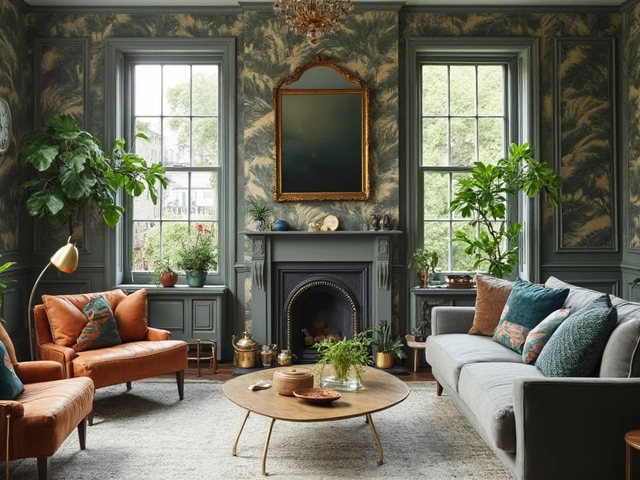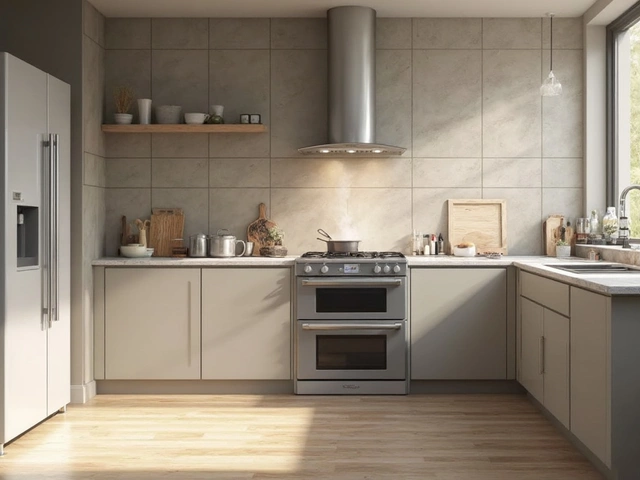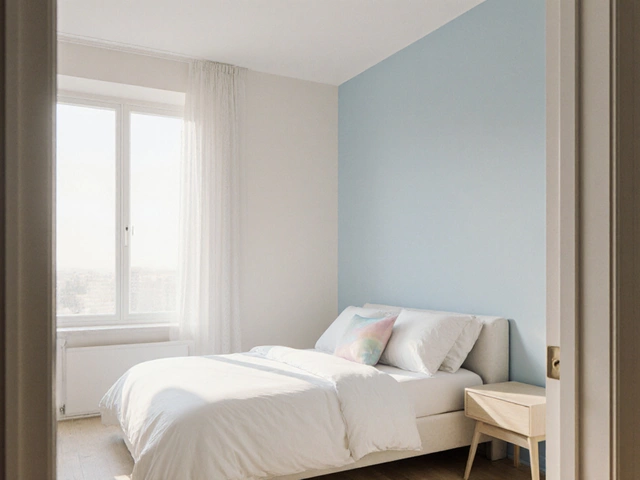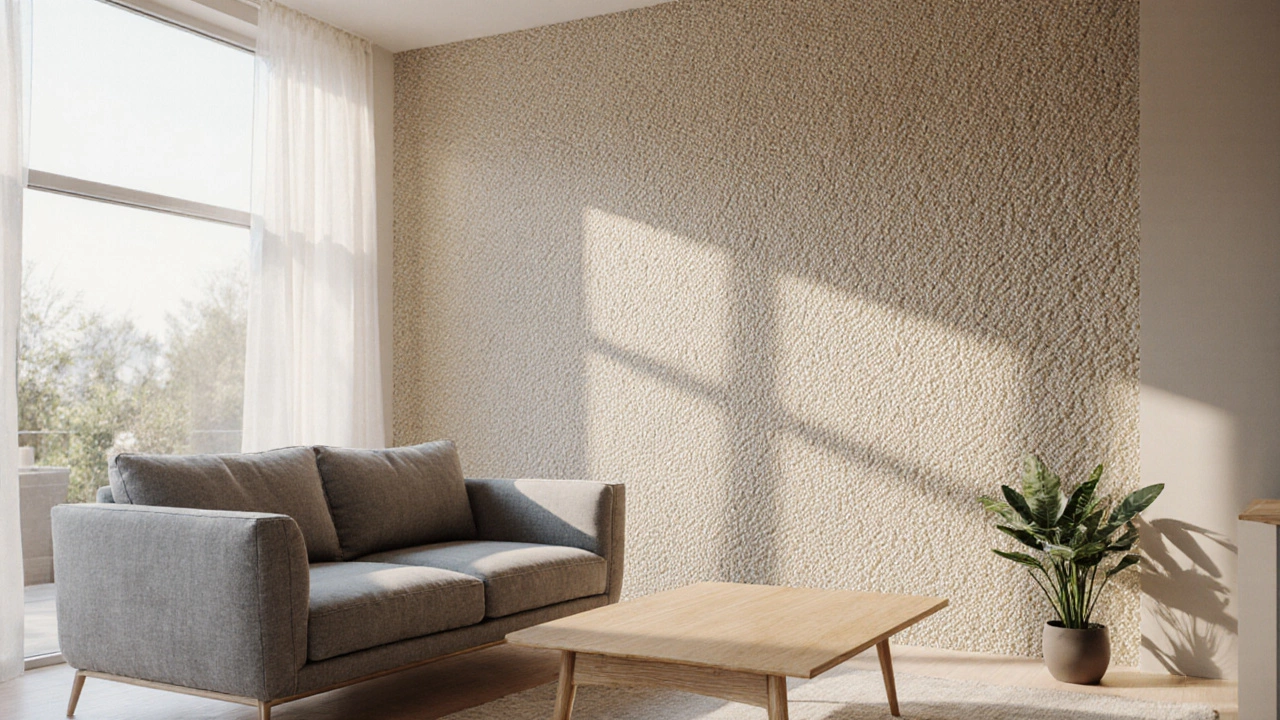
Textured Wallpaper Selector
Recommended Textured Wallpaper
Comparison Table: Textured Wallpaper Types
| Type | Material | Eco Rating | Cost (NZD/m²) | Best Use |
|---|---|---|---|---|
| Recycled Paper | Post-consumer paper pulp | High | 30-45 | Living rooms, bedrooms |
| Vegan Grasscloth | Bamboo + hemp fibers | Very High | 45-70 | Accent walls, hotels |
| 3-D Printed Panels | PLA or biodegradable resin | Medium | 70-110 | Commercial lobbies, lofts |
| Fabric-Backed Vinyl | Vinyl with woven backing | Low | 55-80 | High-traffic corridors |
When you hear textured wallpaper is a wallcovering that adds a three‑dimensional feel to a room by using raised patterns, fabric‑like fibers, or embossed designs, you might picture the shaggy walls of the 1970s. But designers are digging into archives, mixing old‑school texture with modern eco‑materials, and the result is popping up on Instagram feeds, in boutique hotels, and even in suburban living rooms. If you’re wondering whether to jump on the trend or wait for the next fad, this guide breaks down the what, why, and how of textured wallpaper in 2025.
Quick Take
- Textured wallpaper is back, driven by sustainability, acoustic benefits, and a craving for tactile spaces.
- Modern options include recycled paper, vegan grasscloth, and 3‑D printable panels that cost 15‑30% more than flat wallpaper.
- Best suited for feature walls, low‑traffic rooms, and spaces where acoustic damping is a plus.
- Installation is similar to flat wallpaper but often needs a stronger adhesive and a smoother substrate.
- Pair with neutral paint, matte lighting, and simple furnishings to let texture shine without overwhelming the room.
Why Texture Is Trending Again
Two big forces are pushing textured wallcoverings forward. First, the pandemic made people value comfort and sensory richness at home. A smooth, white wall can feel sterile, while a subtle tactile surface invites touch and adds visual depth. Second, the design world is moving toward sustainable materials that reduce waste and carbon footprints. New manufacturers are printing textures from recycled fibers, bamboo pulp, and even algae‑based inks, turning eco‑friendly choices into style statements.
Design publications like Elle Decor and Architectural Digest have highlighted textured finishes in their 2025 trend reports, noting a shift from glossy, high‑shine surfaces to “soft‑edge” aesthetics that feel more human.
What Types of Textured Wallpaper Are Available
Not all textures are created equal. Below is a snapshot of the main categories you’ll encounter in showrooms and online stores.
| Type | Material | Eco Rating | Typical Cost (NZD/m²) | Best Use |
|---|---|---|---|---|
| Recycled Paper | Post‑consumer paper pulp | High | 30‑45 | Living rooms, bedrooms |
| Vegan Grasscloth | Bamboo + hemp fibers | Very High | 45‑70 | Accent walls, hotels |
| 3‑D Printed Panels | PLA or biodegradable resin | Medium | 70‑110 | Commercial lobbies, lofts |
| Fabric‑Backed Vinyl | Vinyl with woven backing | Low | 55‑80 | High‑traffic corridors |
When you pick a type, think about the room’s traffic, moisture levels, and how much you care about the environmental impact. For most home settings, recycled paper or vegan grasscloth offers the best balance of look, feel, and sustainability.
How Textured Wallpaper Fits Into 2025 Interior Design Trends
Design experts categorize 2025 as a year of “organic modernism.” That means clean lines paired with natural textures. Textured wallpaper plays a starring role in four main style corridors:
- Maximalist Warmth: Deep jewel tones on a velvety grasscloth create a cozy, layered feel.
- Scandinavian Minimalism: Light‑gray linen‑like textures keep rooms bright while adding subtle depth.
- Biophilic Spaces: Nature‑inspired patterns (leaf veins, bark) printed on recycled paper bring the outdoors in.
- Industrial Chic: Rough concrete‑look 3‑D panels work great in loft conversions.
Notice the common thread: texture is used as a backdrop, not a competing focal point. Pair it with neutral paint on adjoining walls, matte metal fixtures, and simple wooden furniture to let the wall speak without shouting.
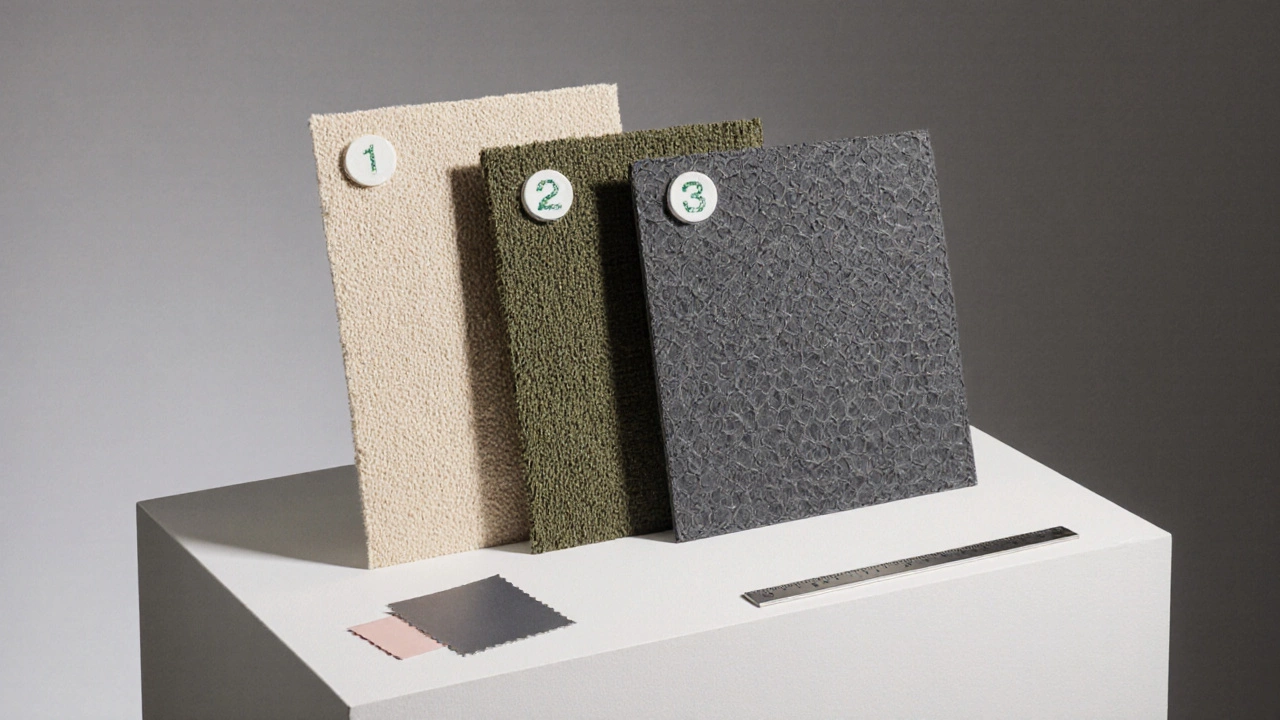
Acoustic and Practical Benefits
Beyond looks, textured wallcoverings can improve room acoustics. The uneven surface helps break up sound waves, reducing echo in open‑plan spaces. In a recent Auckland pilot project, a boutique café installed 3‑D printed acoustic panels that cut ambient noise levels by 8decibels-enough to make conversations feel more intimate.
From a durability standpoint, many textured options are washable. The vinyl‑backed versions can be wiped clean, while paper‑based textures tolerate gentle spot cleaning. If you’re concerned about pets or kids, choose a low‑pile grasscloth that resists snagging.
Installation: What to Expect
Installing textured wallpaper is a bit more involved than hanging flat paper, but it’s still a doable DIY project for a confident homeowner.
- Prepare the wall: sand any imperfections, clean with a mild detergent, and apply a primer if the surface is glossy.
- Choose the right adhesive: heavy‑duty paste works best for paper‑based textures; a polymer‑based glue is recommended for vinyl‑backed or 3‑D panels.
- Measure and cut: leave an extra 5cm on each side for trimming.
- Apply paste to the back (not the wall) for paper textures to prevent bubbling.
- Press the sheet onto the wall, using a smooth roller to work out air pockets. For 3‑D panels, a light tapping tool helps the edges settle.
- Trim excess with a sharp utility knife and seal edges with a clear acrylic caulk if the room is humid.
Most suppliers provide a sample swatch. Stick it on the wall for a day to see how the texture reads under your home’s lighting. If the sample feels too busy, consider using the textured wallpaper on a single accent wall instead of all four sides.
Cost Considerations and ROI
Expect to pay 15‑30% more per square metre than standard flat wallpaper. However, the added visual impact can increase a home’s perceived value, especially in markets where buyers look for unique design touches. In Auckland’s recent property sales data, homes with high‑quality texture finishes fetched an average of NZD5,200 extra compared to similar properties with plain paint.
When budgeting, include:
- Material cost (see the comparison table above)
- Adhesive and primers (≈NZD8‑12 per roll)
- Tools: smoothing roller, utility knife, and a sturdy ladder
- Professional installation (NZD70‑100 per hour) if you’re not comfortable with the extra steps.
Tips to Make Textured Wallpaper Work for You
- Start Small: Choose a focal wall behind the sofa or headboard.
- Mind the Light: Textures look richer in natural light; avoid placing them in rooms with only harsh LED.
- Mix Finishes: Pair a muted texture with glossy metal accents for a balanced contrast.
- Test for Humidity: In bathrooms, opt for vinyl‑backed options that resist moisture.
- Consider Future Trends: Neutral palettes keep the wall adaptable if you decide to switch styles later.
Is Textured Wallpaper Right for Your Space?
Answering this question boils down to three practical checks:
- Purpose: Do you want a statement piece or a subtle backdrop? For a bold statement, go big with 3‑D panels; for subtle depth, choose recycled paper.
- Traffic: High‑traffic areas (hallways, kids’ rooms) benefit from washable vinyl‑backed textures.
- Budget: If you’re on a tight budget, limit the texture to one wall and use paint on the rest.
When those boxes line up, textured wallpaper not only looks fresh-it adds acoustic comfort, sustainability points, and a tactile charm that flat paint can’t match.
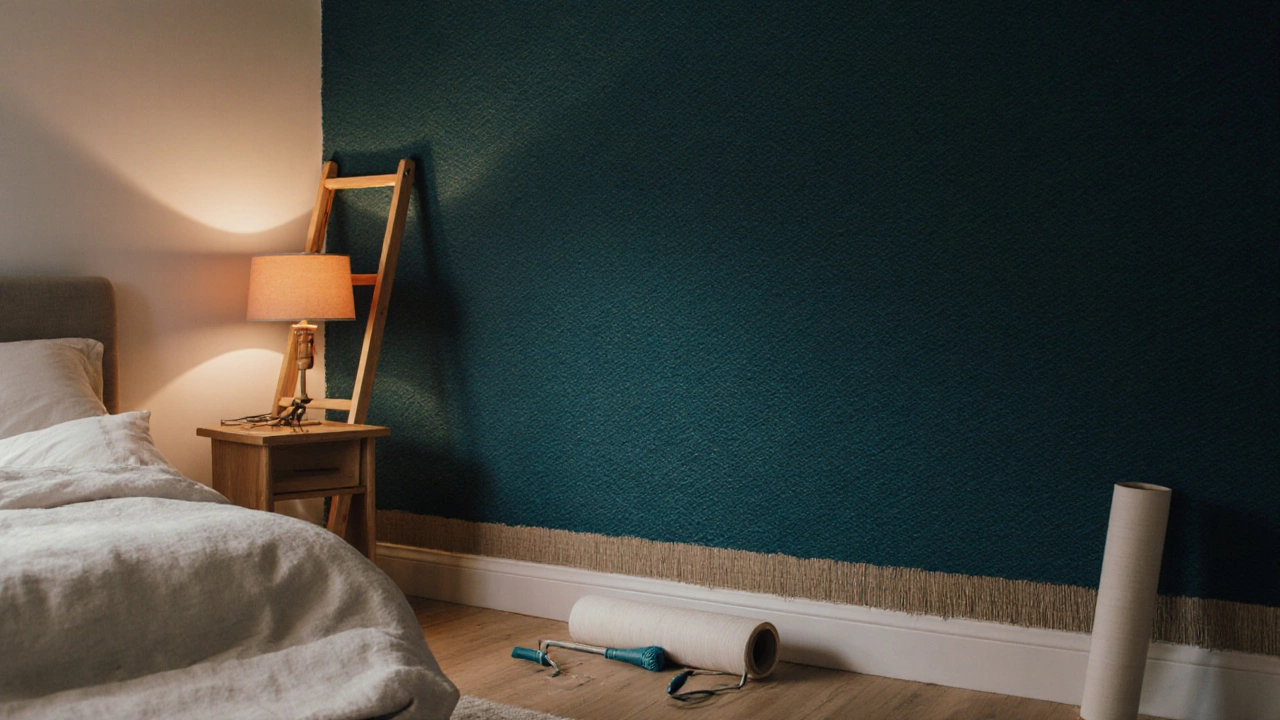
Frequently Asked Questions
Can textured wallpaper be removed without damaging the wall?
Yes, most modern textured wallpapers are designed for peel‑and‑stick removal. Heat a hair‑dryer on low to soften the adhesive, then gently pull the sheet away. For glued‑down papers, a steamer or a commercial adhesive remover may be necessary, but it usually leaves the wall intact if you prime first.
Do I need special tools for installing 3‑D printed panels?
A light‑weight rubber mallet, a small trowel for adhesive, and a level are the basics. Some brands ship pre‑cut panels that snap together, reducing the need for heavy tools.
How does textured wallpaper affect room acoustics?
The uneven surface diffuses sound waves, cutting down on echoes. In open‑plan living areas, the effect can lower ambient noise by 5‑10dB, making conversation easier without adding bulky acoustic panels.
Is textured wallpaper safe for households with pets?
Most vegan grasscloth and recycled‑paper options are resistant to pet claws and can be spot‑cleaned with a damp cloth. Avoid low‑pile fabrics that might snag.
What colour palettes work best with textured walls?
Neutral shades (soft greys, warm beiges) let the texture shine. If you prefer colour, choose muted earth tones or deep jewel hues for a dramatic look without overwhelming the senses.
